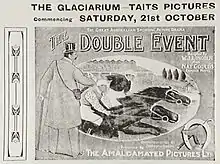| The Double Event | |
|---|---|
 Contemporary advertisement | |
| Directed by | W. J. Lincoln |
| Written by | W. J. Lincoln[1] |
| Based on | novel by Nat Gould |
| Produced by | William Gibson Millard Johnson John Tait Nevin Tait |
| Starring | The Bland Holt Company |
| Cinematography | Orrie Perry |
Production company | |
Release date | 21 October 1911 (Melbourne)[2] |
Running time | 3,000 feet[3] |
| Country | Australia |
| Languages | Silent film English intertitles |
The Double Event is a 1911 Australian feature-length film directed by W. J. Lincoln based on the first novel by Nat Gould, which had been adapted several times for the stage, notably by Bland Holt.[4]
It was one of several films Lincoln made with the Tait family, who had produced The Story of the Kelly Gang.[5]
It is considered a lost film.
Plot
Jack Drayton discovers his brother is an attempted murderer but won't expose him out of fear of ruining the family name. He leaves England in secrecy and starts a new life in Australia under the name of Jack Marston. He falls in love with Edith the daughter of a Sydney bookmaker, John Kingdon. He enters his horse, Caloola, in the Melbourne Cup and it wins, despite the attempts of evil Fletcher.
Fletcher later shoots a lady he is trying to blackmail and is chased across town but is eventually cornered in Chinatown and falls to his death. Jack marries Edith and returns to England.[6]
Cast
- The Bland Holt Company
- Martyn Hagen[7]
Production
The story was based on an 1891 novel by Nat Gould, The Double Event, or A Tale of the Melbourne Cup. This had been successfully adapted for the stage in Australia in 1893 by George Darrell[8] and Bland Holt. Holt's company had disbanded in 1909 and his actors performed in the movie. Several scenes were shot at Flemington Racecourse in Melbourne.[9]
Other scenes were shot at a studio in St Kilda. Assisting Lincoln was Sam Crew.[10]
Release
The film was released in Melbourne on Caulfield Cup Day 1911. In November 1911 The Bulletin wrote that "At the Glaciarium (Melb.). last week, the Taits unreeled a long photodrama of "The Double Event", adapted by W.J. Lincoln. This up-to-date local production seems intended to educate the guileless in the ways of horses and the wiles of villains."[11]
References
- ↑ "THE PLAYGOER". Punch (Melbourne, Vic. : 1900 – 1918; 1925). Melbourne, Vic.: National Library of Australia. 19 October 1911. p. 36. Retrieved 8 June 2015.
- ↑ Mary Bateman, 'W.J. Lincoln', Cinema Papers, June–July 1980 p 214
- ↑ "AMUSEMENTS". The Examiner. Launceston, Tas.: National Library of Australia. 6 March 1912. p. 3 Edition: DAILY. Retrieved 29 January 2012.
- ↑ "Advertising". The Examiner. Launceston, Tas.: National Library of Australia. 9 March 1912. p. 9 Edition: DAILY. Retrieved 29 January 2012.
- ↑ Endean, Lin (13 December 1933). "134 Years in the Industry: The Perrys' Record identifier". Everyones. p. 44.
- ↑ 'The Double Event' at www.natgould.org
- ↑ "LIFE & LETTERS". The West Australian. Perth: National Library of Australia. 4 May 1946. p. 5. Retrieved 16 September 2013.
- ↑ Eric Irvin, Gentleman George: King of Melodrama, University of Qld, 1980 p 182-183
- ↑ Andrew Pike and Ross Cooper, Australian Film 1900–1977: A Guide to Feature Film Production, Melbourne: Oxford University Press, 1998, 27.
- ↑ "Sam Crew Enters 'When London Sleeps' Controversy". Everyones. 12 October 1932. p. 19.
- ↑ "SUNDRY SHOWS". The Bulletin. 2 November 1911. p. 2.
External links
- The Double Event at IMDb
- The Double Event at AustLit
- The Double Event at National Film and Sound Archive
- Page on the book at Nat Gould's website